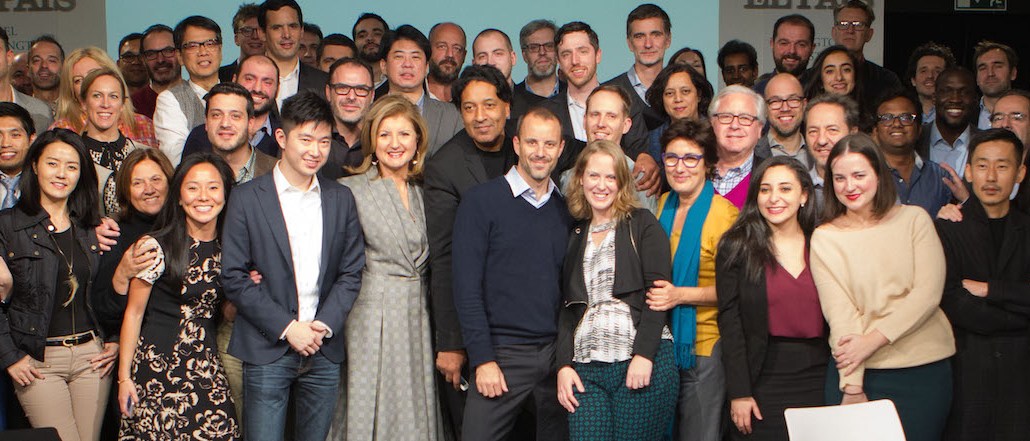Save 50% on a 3-month Digiday+ membership. Ends Dec 12.
Arianna Huffington outlines the next chapter of The Huffington Post’s overseas expansion

The Huffington Post is charting a path to global domination. In Madrid yesterday, The Huffington Post’s 75 editors-in-chief and business leaders from around the world congregated to discuss the digital publisher’s road map. And it’s ambitious: HuffPo wants to be in 50 countries by the end of this decade.
The publisher, which celebrated its 10th birthday this May and has 15 international editions, will center its expansion around some core areas: building a global newsroom, taking a more agile approach to international expansion, investing in technology infrastructure to support its global cross-platform editorial output, and “doubling down” on native advertising.
Speaking to Digiday, Huffington Post president and editor-in-chief Arianna Huffington outlined how it plans to do it:
Using its global network as “laboratories”
Huffington Post plans to use its global reach as an advantage in trying out new approaches. Huffington likened the global network to a series of “laboratories.” She cited Germany as a leader in video and South Korea and Japan as the most advanced in mobile.
“It’s not just the U.S. that leads. In Korea, 90 percent of HuffPost’s traffic comes from mobile. And Japan, where 72 percent of traffic is from mobile, has built the largest HuffPost audience outside the U.S,” she said.
Building a global newsroom
Like all global news outlets, The Huffington Post’s coverage has recently been dominated by the Paris attacks. More than 150 articles were created in total, translated and shared across its global network, along with dozens of videos.
France editor-in-chief Anne Sinclair’s “Morning of War” blog post in response to the attack was translated into nine languages in the HuffPost network and was featured on every edition, while global editorial director Howard Fineman’s blogpost “We Are All Parisians, Again” was featured across 10 editions, including France.
HuffPo’s Mothers of ISIS series saw a surge of 500,000 views after the Paris attacks, the majority of which came via social channels, taking the total number of views for that series to 1.1 million across 10 countries, half of which came from social.
“The recent events in Paris showed the power of real-time collaboration among all our editions,” said Huffington.
She wants to capitalize on this further, ramping up teams in countries where political elections are imminent and investing in new technologies — HuffPo’s content management system, analytics tools and apps — to better enable rapid content sharing across all its editions, and faster translation capabilities.
Scaling its global news capabilities further is also important as it edges toward its severance from using Associated Press stories at the end of this year.
The publisher also wants its network of 100,000 bloggers to expand to 1 million, according to Huffington.
Native advertising everywhere
On the business side, native advertising is the focus, according to Huffington. HuffPo already has its native ad HuffPost Partner Studios up and running internationally, but there are further plans to increase native advertising, she said.
Huffington is probably the most noted figure in media for her advocacy of health and mindfulness and her policy of ensuring good sleeping patterns. She said this is an area around which brands also increasingly want to associate themselves, and native advertising partnerships can be the vehicle. “Brands want to be around content that resonates,” she said. “The more ad blocking becomes a big issue, the more brands are looking for emotionally resonant campaigns, and not just the typical banner ads,” she added.
The outlook
Huffington Post ranks high with media buyers, according to Havas Media’s head of publishing Dominic Fawkes. It has a solid place on the media plan due to its varied media formats and sponsorship opportunities around unique content. Internationally, it will need to demonstrate it can provide platform consistency across all its editorial products, some of which are managed by its third-party media partners.
“We want to know we can use the same methodology for buying across each market so we can provide consistency to global advertisers,” he added.
More in Media

Meta enters AI licensing fray, striking deals with People Inc., USA Today Co. and more
The platform has secured seven multi-year deals with publishers including CNN, Fox News, People Inc., USA Today Co to incorporate their content into its large language model (LLM) Llama.

European publishers say the Digital Omnibus ‘cookie fix’ leaves them worse off
The European Union’s attempt at a legislative spring clean for Europe’s web of data privacy rules, has landed flat with publishers.

Digiday+ Research Subscription Index 2025: Subscription strategies from Bloomberg, The New York Times, Vox and others
Digiday’s third annual Subscription Index examines and measures publishers’ subscription strategies to identify common approaches and key tactics among Bloomberg, The New York Times, Vox and others.





